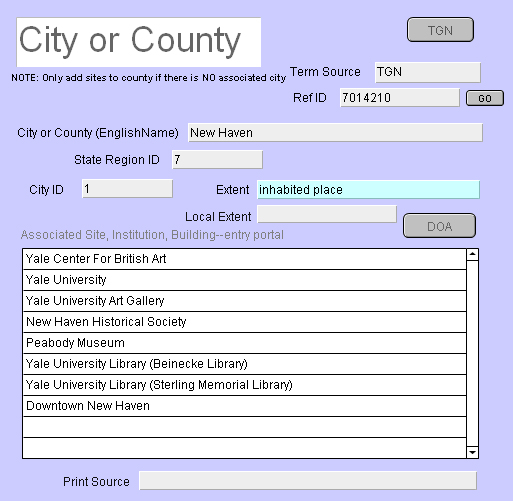Vcat
Best Practices:
CityOrCounty
Part
of the Locations hierarchy, CityOrCounty establishes the position of places
larger than a building or site, but smaller than a state or region. TGN terms
that are qualified “inhabited places” usually fit here. Generally, the form of
the place name will follow the Authority from whence it came. There are two
local exceptions to this rule: Entries for Oregon cities are qualified by their
county, i.e. “Eugene (Lane)”, and Japanese cities are qualified by their
prefecture, i.e. “Yonezawa (Yamagata-ken)”. In the
case of Japanese cities, the established hierarchy leaves out a very important subdivision
between StateRegion and CityOrCounty, so this compromise was made. It is
important that the primary key for the StateRegion be entered accurately, or
the City will not appear in the Locations entry fields of the Work record.
Note:
The Locations hierarchy may contain “unknown” as entries. These are used only
when you have a named entity smaller than a continent wherein you cannot
establish one or more parts of the hierarchy ABOVE it. No Location hierarchy should
end in “unknown.”
TGN
button:
Opens the Getty Thesaurus of Geographic Names Online
DOA
button:
Opens Grove Art Online Locations Appendix
Go button: opens the specific
record for the source, if the Ref ID is filled out

|
Field
Name |
Local
Usage |
Notes |
|
Term Source |
Pull-down menu |
Standard short list of
online Authorities |
|
Ref ID |
Use for Authority reference
numbers, as source |
The identification given
to the authority record by the authority source |
|
City or County |
Use
Title Case; use parentheses
for county qualifiers, i.e. “Eugene (Lane)” |
The only entries that
regularly use qualifiers are cities in Oregon, followed by the county, or
cities in Japan, followed by the prefecture. |
|
State Region ID |
Enter from StateRegion Table |
Primary key for the
StateRegion facet |
|
City ID |
Auto-generated |
Primary key for the
CityOrCounty facet |
|
Extent |
Pull-down menu |
|
|
Local Extent |
Free text |
Since the Extent is an unmodifiable
field (green), but does not contain all possible extents, use this field
in conjunction with the Extent field to indicate a more precise extent.
In other words, if you need to use Local Extent, you must choose the
closest entry under Extent as well. |
|
Portal |
Auto-entered, editable |
Auto-fills with records from
the next tier down in the hierarchy (in this case SiteInstitutionBuilding.)
|
|
Print Source |
Pull-down menu or MLS
format |
If the Term Source is Print
or Web, you must indicate the book or URL. The pull-down option shows
all Source records. Click in the box and type if the source is not part
of the Source table. |
Continue
to SiteInstitutionBuilding